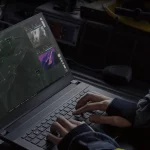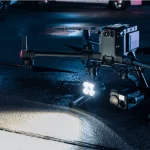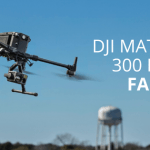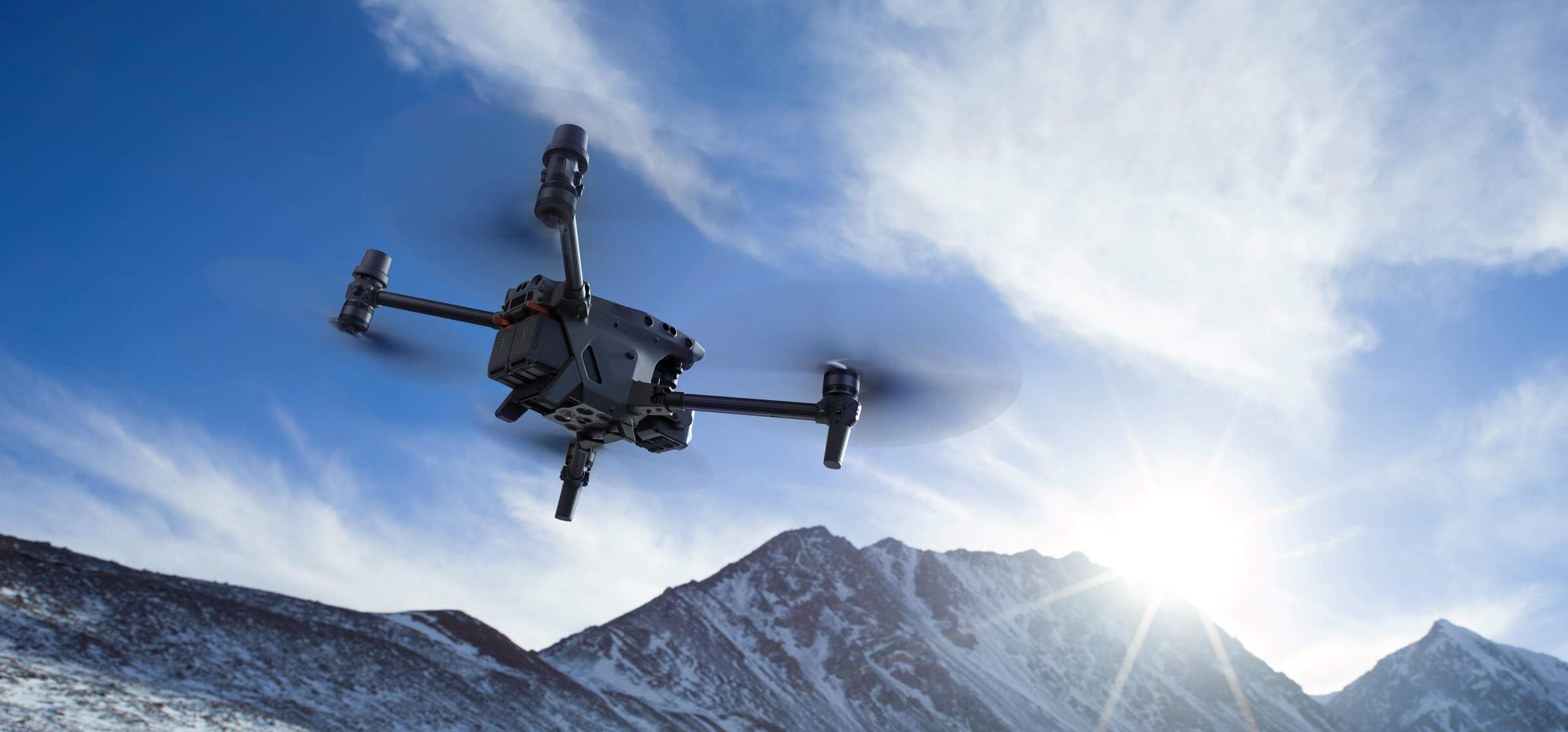
Matrice 30 (T)
CONTENTS
About the Product
On March 21, 2022, DJI Innovations unveiled a top-of-the-line complete solution that combines: The latest Matrice 30 (T) portable all-weather drone series, the latest DJI Dock all-weather dock station and the second generation of FlightHub 2 universal cloud platform for managing drone operations – unique hardware and software with the potential to take human performance in applications such as firefighting, search and rescue, power line monitoring, pipeline inspection, well inspection and law enforcement to the next level, where portability is combined with power without loss in quality or functionality.
In this review, as always, we have compiled information about each component of the latest system in full to ensure that the reader is quickly and fully acquainted with the tools presented, which will ultimately allow everyone to make their correct and objective choice. Traditionally, let’s start with the key features of DJI’s newest enterprise solution.
Features
Key features of the latest enterprise solution:
- New portable drone design inherited from the M300RTK and M3
- New foldable carbon fiber drone design
- Drone flight weight: 3,770g
- Max. altitude above sea level: 7,000 meters
- DJI O3 Enterprise digital video streaming technology (OcuSync Enterprise) with support for 3-channel video streaming
- Max. distance FPV removal 15 km Video stream quality 1080P
- AES-256 data encryption algorithm
- Satellite Positioning: GPS + GLONASS + BeiDou + Galileo
- RTK positioning
- 6-way positioning system and obstacle detection
- Degree of protection IP55
- Powered by 2 × battery (5,880 mAh each)
- Max flight time 41 min
- Hot-swappable batteries
- Operating temperature range -20°C to 50°C
- Automatic battery heating
- Max. cruising speed 82.8km/h
- Max. permissible wind speed (wind resistance) 15m/s
- New M30 multifunction compact camera (Matrice 30 only) combines three sensors: a wide-angle camera, a zoom camera and a laser rangefinder
- New M30T all-in-one compact camera (Matrice 30T only) combining four sensors: wide-angle camera, zoom camera, laser rangefinder and thermal imager)
- 6 × intelligent modes and functions for automated drone operation (Live Mission Recording/AI Spot-Check/Waypoints 2.0/Smart Pin & Track/PinPoint/Smart Track
- Smart Low-Light Photo mode for low-light photography
- Advanced Dual Operator mode
- ADS-B receiver (DJI AirSense technology)
- Professional aircraft level flight telemetry and navigation
- Duplication of all key sensors for safe piloting and accurate positioning of the UAV
- New DJI RC Plus remote control (with built-in super-bright 7-inch display, water and dust proof IP54, with built-in and external power supply)
- Support for operation with the D-RTK 2 mobile station
- New DJI Pilot 2 mobile app
- New web-based control center for DJI FlightHub 2
- Support for operation with DJI Dock, the latest all-weather automatic docking station (only relevant to the M30(T) Dock version)
- Support for Mobile SDK, Payload SDK, Cloud API
- Onboard warning lights
Configuration
The developer offers the Matrice 30 series drone as well as a complete solution based on the Matrice 30 series drone in four packages:
- DJI M30 Package (Includes: Drone/2 × battery/charging station/ DJI RC Remote Plus/ DJI Pilot/ DJI FlightHub 2 (with a 3-month subscription)/ one-year DJI Care Enterprise insurance package)
- DJI M30T Package (Includes: Drone/2 × Battery/charging station/ DJI RC Remote Control Plus/ DJI Pilot/ DJI FlightHub 2 software (with a 3-month subscription)/ one-year DJI Care Enterprise insurance package)
- DJI Dock + M30 Dock version (Includes Dock + M30 drone)
- DJI Dock + M30T Dock version (Includes Dock + M30T Drone)
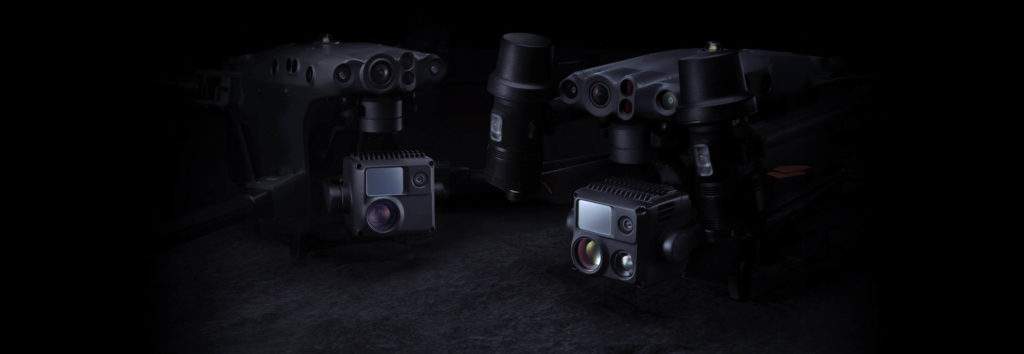
For information! DJI Dock is only compatible with the M30 Dock and M30T Dock versions, and will not work with regular M30 series drones. This is because the drones in the M30 Dock version have small differences in the housing to ensure compatibility with the DJI Dock. This means that if you buy a regular version of the drone, you will not be able to retrofit it with the docking station in the future. Keep this in mind before buying!
Specification
Drone
| Dimensions (unfolded, excl. propellers) |
470×585×215 mm (L×W×H) |
| Dimensions (folded) | 365×215×195 mm (L×W×H) |
| Diagonal Wheelbase | 668 mm |
| Weight (incl. two batteries) | 3770 ± 10 g |
| Max Takeoff Weight | 3998 g |
| Operation Frequency[1] | 2.4000-2.4835 GHz; 5.725-5.850 GHz |
| Transmitter Power (EIRP) | 2.4 GHz: <33 dBm (FCC); <20 dBm (CE/SRRC/MIC) 5.8 GHz: <33 dBm (FCC/SRRC); <14 dBm (CE) |
| Hovering Accuracy (windless or breezy) | Vertical: ±0.1 m (Vision System enabled); ±0.5 m (N-mode with GPS); ±0.1 m (RTK) Horizontal: ±0.3 m (Vision System enabled); ±1.5 m (N-mode with GPS); ±0.1 m (RTK) |
| RTK Positioning Accuracy (fixed RTK enabled) | 1 cm+1 ppm (horizontal) 1.5 cm+1 ppm (vertical) |
| Max Angular Velocity | Pitch: 150°/sec.; Yaw: 100°/sec. |
| Max Tilt Angle | 35° (N-mode and Forward Vision System enabled: 25°) |
| Max Ascent/Descent Speed | 6 m/s, 5 m/s |
| Max Tilt Descent Speed | 7 m/s |
| Max Horizontal Speed | 23 m/s |
| Max Service Ceiling Above Sea Level (without other payload) | 5,000 m (with 1671 propellers) 7,000 m (with 1676 propellers) |
| Max Wind Resistance | 15 m/s 12 m/s during taking off and landing |
| Max Hover Time [2] | 36 min |
| Max Flight Time[2] | 41 min |
| Motor Model | 3511 |
| Propeller Model | 1671 1676 High Altitude (not included) |
| Ingress Protection Rating[3] | IP55 |
| GNSS | GPS+Galileo+BeiDou+GLONASS (GLONASS is supported only when RTK module is enabled) |
| Operating Temperature | -20° to 50° C (-4° to 122° F) |
Gimbal
| Angular Vibration Range | ±0.01° |
| Controllable Range | Pan: ±90° Tilt: -120° to +45° |
| Mechanical Range | Pan: ±105° Tilt: -135° to +60° Roll: ±45° |
Zoom Camera
| Sensor | ±0.01° |
| Controllable Range | 1/2″ CMOS, Effective pixels: 48M |
| Lens | Focal length: 21-75 mm (equivalent: 113-405 mm) Aperture: f/2.8-f/4.2 Focus: 5 m to ∞ |
Wide Camera
| Sensor | ±0.01° |
| Controllable Range | 1/2″ CMOS, Effective pixels: 12M |
| Lens | DFOV: 84° Focal length: 4.5 mm (equivalent: 24 mm) Aperture: f/2.8 Focus: 1 m to ∞ |
Thermal Camera
| Thermal Imager | Uncooled VOx Microbolometer |
| Lens | DFOV: 61° Focal length: 9.1 mm (equivalent: 40 mm) Aperture: f/1.0 Focus: 5 m to ∞ |
| Infrared Temperature Measurement Accuracy[4] | ±2°C or ±2% (using the larger value) |
FPV Camera
| Resolution | 1920×1080 |
| DFOV | 161° |
| Frame Rate | 30 fps |
Laser Module
| Wavelength | 905 nm |
| Max Laser Power | 3.5 mW |
| Single Pulse Width | 6 ns |
| Measurement Accuracy | ± (0.2 m + D×0.15%) D is the distance to a vertical surface |
| Measuring Range | 3-1,200 m (0.5×12 m vertical surface with 20% reflectivity) |
Vision Systems
| Obstacle Sensing Range | Forward: 0.6-38 m Upward/Downward/Backward/Sideward: 0.5-33 m |
| FOV | 65° (H), 50° (V) |
| Operating Environment | Surfaces with clear patterns and adequate lighting (> 15 lux) |
Infrared Sensing Systems
| Obstacle Sensing Range | 0.1 to 10 m |
| FOV | 30° |
| Operating Environment | Large, diffuse, and reflective obstacles (reflectivity >10%) |
TB30 Intelligent Flight Battery
| Capacity | 5880 mAh |
| Voltage | 26.1 V |
| Battery Type | Li-ion 6S |
| Energy | 131.6 Wh |
| Net Weight | Approx. 685 g |
| Operating Temperature | -20° to 50° C (-4° to 122° F) |
| Storage Temperature | 20° to 30° C (68° to 86° F) |
| Charging Temperature | -20° to 40° C (-4° to 104° F) (When the temperature is lower than 10° C (50° F), the self-heating function will be automatically enabled. Charging in a low temperature may shorten the lifetime of the battery) |
| Chemical System | LiNiMnCoO2 |
Auxiliary Lights
| Effective Illumination Distance | 5 m |
| Illumination Type | 60 Hz, solid glow |
Remote Controller
| Screen | 7.02 inch LCD touchscreen, with a resolution of 1920×1200 pixels, and high brightness of 1200 cd/m2 |
| Internal Battery | Type: Li-ion (6500 mAh @ 7.2 V) Charge Type: Supports battery station or USB-C charger maximum rated power 65W (max voltage of 20V) Charge Time: 2 hours Chemical System: LiNiCoAIO2 |
| External Battery (WB37 Intelligent Battery) | Capacity: 4920 mAh Voltage: 7.6 V Battery Type: Li-ion Energy: 37.39 Wh Chemical System: LiCoO2 |
| Operating Time[5] | Internal Battery: Approx. 3 hours 18 min Internal Battery + External Battery: Approx. 6 hours |
| Ingress Protection Rating[3] | IP54 |
| GNSS | GPS+Galileo+BeiDou |
| Operating Temperature | -20° to 50° C (-4° to 122° F) |
O3 Enterprise
| Operating Frequency[1] | 2.4000-2.4835 GHz, 5.725-5.850 GHz |
| Max Transmission Distance (unobstructed, free of interference) | 15 km (FCC); 8 km (CE/SRRC/MIC) |
| Max Transmission Distance (with interference) | Strong Interference (urban landscape, limited line of sight, many competing signals): 1.5-3 km (FCC/CE/SRRC/MIC) Medium Interference (suburban landscape, open line of sight, some competing signals): 3-9 km (FCC); 3-6 km (CE/SRRC/MIC) Weak Interference (open landscape abundant line of sight, few competing signals): 9-15 km (FCC); 6-8 km (CE/SRRC/MIC) |
| Transmitter Power (EIRP) | 2.4 GHz: <33 dBm (FCC); <20 dBm (CE/SRRC/MIC) 5.8 GHz: <33 dBm (FCC); <14 dBm (CE); <23 dBm (SRRC) |
Wi-Fi
| Protocol | Wi-Fi 6 |
| Operating Frequency[1] | 2.4000-2.4835 GHz; 5.150-5.250 GHz; 5.725-5.850 GHz |
| Transmitter Power (EIRP) | 2.4 GHz: <26 dBm (FCC); <20 dBm (CE/ SRRC/MIC) 5.1 GHz: <26 dBm (FCC); <23 dBm (CE/ SRRC/MIC) 5.8 GHz: <26 dBm (FCC/SRRC); <14 dBm(CE) |
Bluetooth
| Protocol | Bluetooth 5.1 |
| Operating Frequency[1] | 2.4000-2.4835 GHz |
| Transmitter Power (EIRP) | <10 dBm |
BS30 Intelligent Battery Station
| Dimensions | 353×267×148 mm |
| Net Weight | 3.95 kg |
| Compatible Battery Type | TB30 Intelligent Flight Battery WB37 Intelligent Battery |
| Input | 100-240 VAC, 50/60 Hz |
| Output | TB30 Battery Port: 26.1 V, 8.9 A (supported up to two outputs simultaneously) WB37 Intelligent Battery: 8.7 V, 6 A |
| Output Power | 525 W |
| USB-C port | Max. output power of 65 W |
| USB-A port | Max. output power of 10 W (5 V, 2 A) |
| Power Consumption (when not charging battery) | < 8 W |
| Output Power (when warming up battery) | Approx. 30 W |
| Operating Temperature | -20° to 40° C (-4° to 104° F) |
| Ingress Protection Rating[3] | IP55 (with the cover closed properly) |
| Charging Time[6] | Approx. 30 min (charging two TB30 batteries from 20% to 90%) Approx. 50 min (charging two TB30 batteries from 0% to 100%) |
| Protection Features | Anti-Backflow Protection Short Circuit Protection Over Voltage Protection Over Current Protection Temperature Protection |
Other
| Footnotes |
|
Drone
Lightweight, reliable and easy to deploy, the all-new DJI Matrice 30 series is designed for commercial use in human applications such as law enforcement, search and rescue, firefighting, power line/ pipeline and well inspection. M30 series was developed from scratch, however, in order to fully realize the potential put for this series, the developer has turned its attention to the two top models of drones own production – a cinematic Mavic 3 and commercial Matrice 300 RTK, where during the painstaking work DJI engineers managed to fit into a new portable housing, the lion’s share of potential M300RTK. At the same time, the developer notes that the Matrice 30 series is not implemented to replace the unique Matrice 300 RTK, but only in addition to it.
Lightweight and portable
Powerful flight performance
- Maximum flight time: 41 min
- Wind resistance: 15 m/s
- Practical ceiling: 7,000 meters
- Maximum horizontal flight speed: 83 km/h.
An all-weather solution
Safety and Reliability
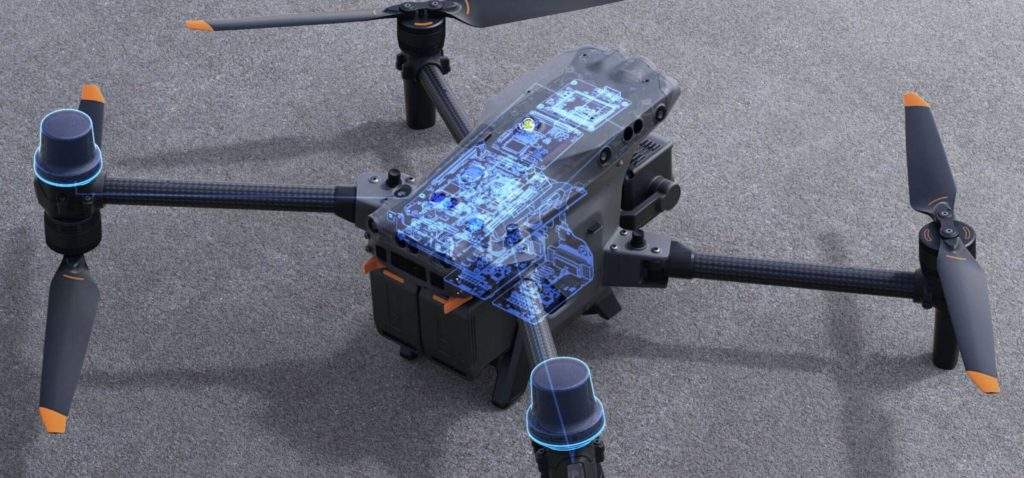
Redundancy of key systems
- Redundant flight control system sensors
- Redundant control signal transmission channels
- Redundant smart batteries
- Redundant data transmission channels
- A redundant sensor system for visualization of the surrounding world
- M30 series drones are adapted for emergency landing on three propellers/motors.
DJI O3 Enterprise
Multifunctional camera system
In developing the camera system, the developer did not reinvent the wheel, but used the proven M20T (weight: 828g) multifunctional camera installed on Matrice 300RTK machines, which was subsequently reduced to the required size while maintaining the same performance and eventually got the name – M30(T) (M30T weight: 320g). So, the Matrice 30 series drones can be equipped with one of the two possible cameras without the possibility of quick replacement/upgrade:
- DJI M30 – the camera built into the 3-axis mechanical suspension has three sensors based on which are implemented: a wide-angle camera, a zoom camera and a laser rangefinder.
- DJI M30T – the camera built into the 3-axis mechanical suspension has four sensors based on which the wide-angle camera, zoom camera, laser rangefinder and thermal imager are implemented.
Key features of the camera system:
- 12-megapixel 1/2-inch CMOS sensor
- Equivalent focal length: 24 mm, FOV: 84°
- Video resolution: 4K/30 fps
Zoom camera
- 48-megapixel 1/2-inch CMOS sensor
- 5-16x optical zoom
- 200x max hybrid zoom
- Photo resolution: 8K
- Video resolution: 4K/30fps
Thermal camera
- Equivalent focal length: 40mm
- Resolution: 640 × 512
- Frame rate: 30 frames per second
- Accuracy: ±2°C or ±2%
Laser rangefinder
- Range: 3 m - 1200 m
- Accuracy: ± (0.2 m + D × 0.15%)
FPV camera
Smart Low-Light Photo
200x Hybrid Zoom
IR Shooting
Laser rangefinder
TB30 Intelligent Flight Battery
Intelligent Battery Station
DJI RC Plus
- 7-inch widescreen display with 1200 cd/m2 brightness
- Water and dust protection IP54
- Operating temperature range from -20°C to 50°C
- Built-in battery (max run time: 3 hours 18 minutes)
- Hot-swappable external battery (max runtime in tandem with built-in battery: 6 hours
- 4 high performance antennas
- Supports OcuSync 3 Enterprise video transmission technology
Exterior
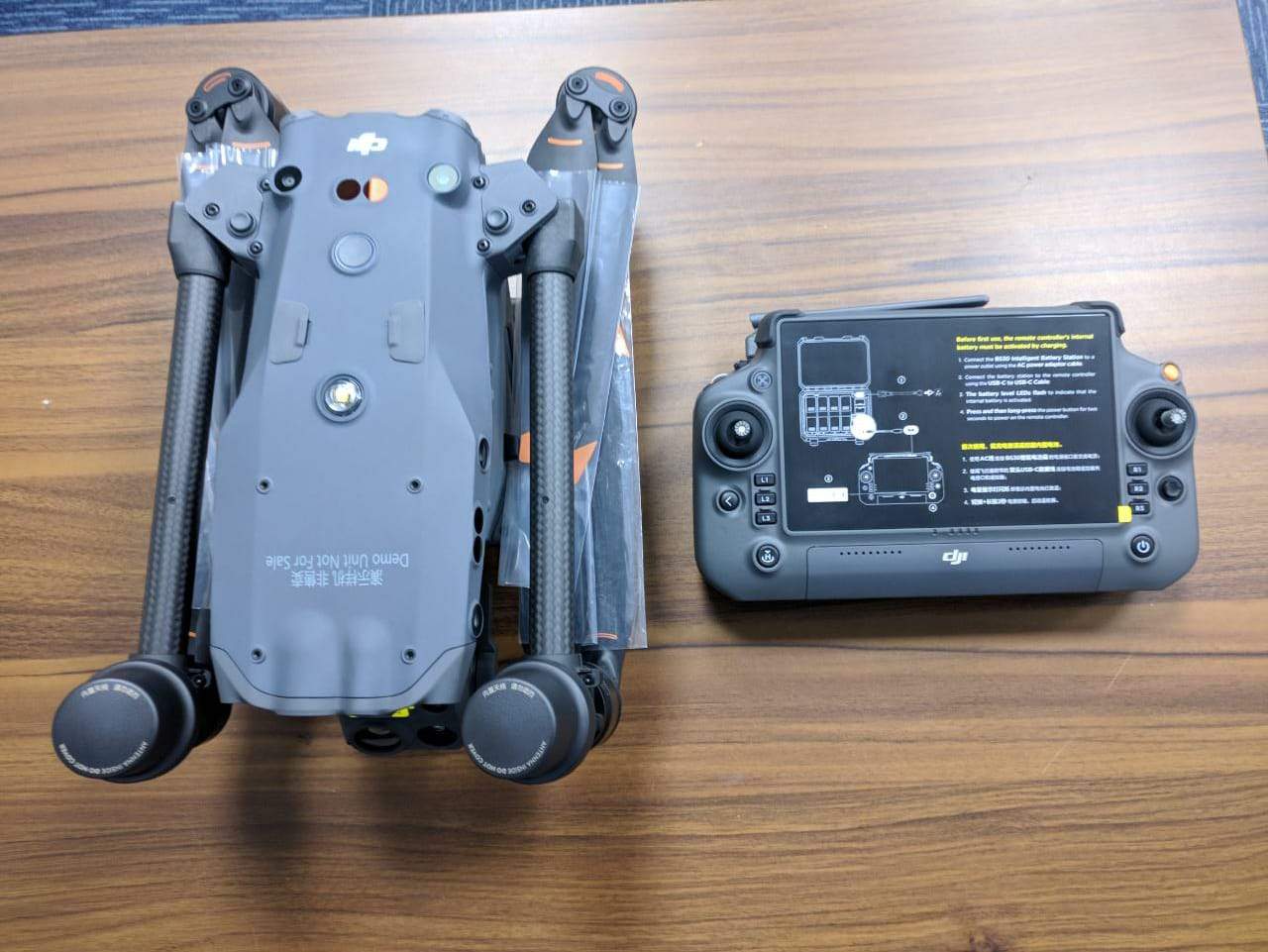
DJI Pilot 2
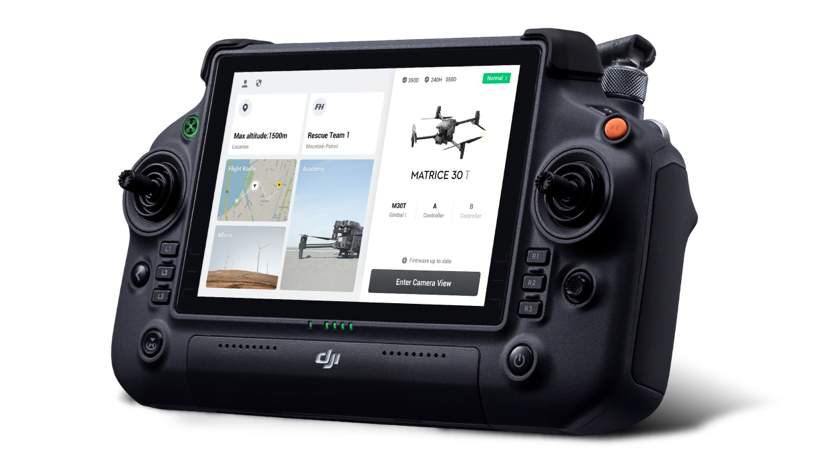
Updated interface
Ergonomic design
Preflight Checklist
Navigation Display
Alerts
DJI FlightHub 2
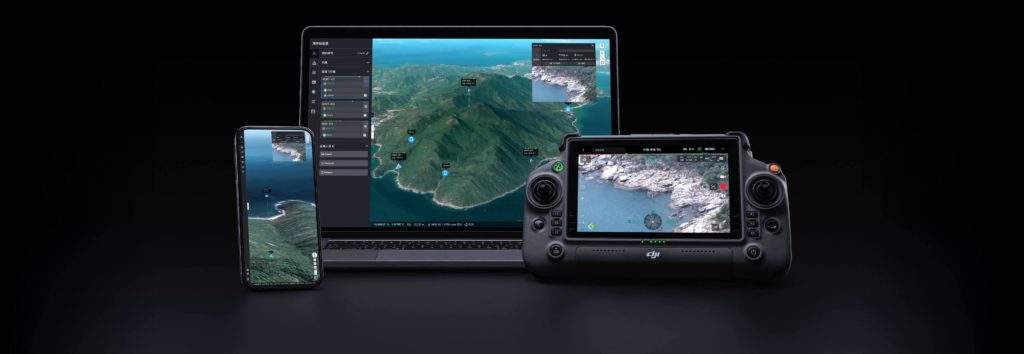
The next announced component of DJI’s enterprise drone ecosystem is the second generation of the versatile cloud-based platform for the comprehensive management of drone fleet operations – FlightHub 2. Now, in addition to the ability to receive live telemetry from each drone involved in a mission, view up to four video streams simultaneously in real time, and coordinate and manage the entire workflow online, the developer has added the following features:
2.5D terrain map
Live Mission Broadcasting
Live annotations
Streamlined team communication
Route planning and management
Smart Inspection
Notes
- A maximum flight time of 41 minutes was achieved by flying the drone at a constant speed of 36 km/h in a windless environment. Actual flight time may vary depending on environment, flight mode, and accessories.
- In contrast to the flight wind speed of 15 m/s, takeoff and landing will be possible at wind speeds up to 12 m/s.
- The maximum declared practical ceiling of 7000 meters can be reached only by retrofitting the drone with high-altitude propellers type 1676.
- The default accuracy of the thermal camera reading is defined by a maximum value of ±2°C or ±2% .
- Laser rangefinder accuracy is ±(0.2 m + D × 0.15%); Where D indicates the distance from a vertical reflective surface.
- The Matrice 30 series (Dock Version) has an optional built-in charging module. It follows that the standard M30 series drones are not compatible with the DJI Dock and cannot be upgraded or modified to become the Dock Version.
- A maximum coverage radius of 7 kilometers when operating the drone in tandem with the DJI dock was obtained in an interference-free zone.
- The TB30’s smart flight battery can perform up to 400 charge cycles in 12 months if it is charged to 90% or higher for less than 120 days. You can view battery information in the DJI Pilot 2 app under “Health Management System/UAV General Status Monitoring and Self-Diagnostic System.
DJI Dock
DJI Dock is the first all-weather landing and charging station from DJI Innovations that allows fully remote automatic programmed flights of Matrice 30 (T) Dock version drones 24/7, day and night, rain and sun.
Features
- Total weight: 99kg
- Area: 1m²
- Integrated and easy to deploy
- IP55 water and dust proof
- Operating temperature range -35℃ to 50℃
- Capable of operating in fully automatic mode
- Max range 7km
- Supports 4G connectivity
- Support cloud control
- Fast charging for minimum downtime (from 10 - 90% in only 25 min)
- Support for private deployment
- Supports Open Edge Computing
- Full FlightHub 2 compatibility
- Built-in overvoltage protection
- Built-in battery backup (up to 5 hours autonomy)
- Built-in wide-angle surveillance camera
- Built-in weather station
- Built-in omni-directional antenna
- Built-in RTK module
- Active temperature monitoring
- Service interval 6 months
- Maximum wind resistance 15 m/s
Accessories
The developer offers the docking station in two packages:
- M30 Dock Version (Includes M30 Dock Version series drone)
- M30T Dock Version (Includes M30T Dock Version series drone)
Specification
| Product Name | DJI Dock |
| Total Weight | 90 kg |
| Dimensions | Cover Open (Weather Station excluded): 1,675 mm×895 mm×530 mm (L×W×H) Cover Closed (Weather Station excluded): 805mm×895mm×840 mm (L×W×H) |
| Input Voltage | 100-240 VAC, 47-63 Hz |
| Max Input Power | 1,500 W |
| Operating Temperature | -35 to 50° C (-31 to 122° F) |
| Ingress Protection Rating | IP55 |
| Number of Drones Accommodated | 1 |
| Max Allowable Landing Wind Speed | 12 m/s |
| Max Operating Altitude | 4,000 m |
| Max Operating Radius | 7,000 m |
| Receiving Frequency of RTK Base Station Satellite | Simultaneously receive: GPS: L1 C/A, L2, L5 BeiDou2: B1l, B2l, B3l BeiDou3:B1l, B1C, B2a, B3l GLONASS:L1, L2 Galileo: E1, E5A, E5B |
| Positioning Accuracy of RTK Base Station | Horizontal: 1 cm+1 ppm (RMS) Vertical: 2 cm+1 ppm (RMS) |
| Output Voltage | 18 to 26.1 V |
| Charging Time | 25 minutes Note: This is if the ambient temperature is 25°C (77° F), and the aircraft is charged from 10% to 90%. |
| Video Transmission System | O3 Enterprise |
| Operating Frequency | 2.4000-2.4835 GHz 5.725-5.850 GHz |
| Antennas | 4 antennas, 2T4R |
| Transmitter Power (EIRP) | 2.4 GHz: <33 dBm (FCC); <20 dBm (CE/SRRC/MIC) 5.8 GHz: <33 dBm (FCC); <14 dBm (CE); <23 dBm (SRRC) |
| Operating Voltage | 48 VDC |
| Air Conditioning Type | TEC Air Conditioning |
| Battery Capacity | 12 Ah |
| Output Voltage | 24 V |
| Battery Type | Lead-acid Battery |
| Backup Battery Life | > 5 hours |
| Ethernet Access | 10/100/1000Mbps Adaptive Ethernet port |
| Wind Speed Sensor | Supported |
| Rainfall Sensor | Supported |
| Ambient Temperature Sensor | Supported |
| Water Immersion Sensor | Supported |
| In-cabin Temperature Sensor | Supported |
| In-cabin Humidity Sensor | Supported |
| Vibration Sensor | Supported |
| Resolution | 1920×1080 |
| Field of View (FOV) | 180° |
| Auxiliary Light | Supported, Auxiliary White Light |
| AC Power Port | 40 kA (8/20μs waveform), meets EN/IEC 61643-11 TYPE 2 protection level requirements |
| Ethernet Port | 1.5 kA (8/20μs waveform), meets EN/IEC 61643-21 CATEGORY C protection level requirements |
| Applications | DJI Pilot 2 (connects to DJI Dock via DJI RC Plus for configuration and commissioning) |
| Cloud Platform | DJI FlightHub 2 3rd Party Platforms through DJI Cloud API |
| Open Protocol | DJI Cloud API |
| Edge Computing | Internal power supply, data interface, and installation space |
Full Cloud Computing Control
Online Awareness
Operation and maintenance
Fast charging
A powerful all-weather solution
The developer has made sure that the docking station works continuously at any time of the day or night, regardless of weather conditions. In particular, the following features contributed to this potential:
- Sand and dust protection: IP55
- Temperature working range: -35℃ to 50℃
- Overvoltage protection: 40kA
- Max run time on built-in backup battery: 5 hours
- Active temperature control to ensure fast charging of drone batteries
- Maintenance interval: 6 months
Broad coverage
Easy installation
Modular maintenance
The developer notes that thanks to the modular design of the main components, maintenance of the docking station will not take much time.
Hardware
DJI Dock is equipped with highly integrated hardware that enhances the functionality of the system:
- Wide-angle security camera
- Integrated weather station
- Built-in omni-directional antenna
- RTC module
- Expansion slot for peripheral calculations
Peripheral Computing
Private deployment
Notes
- The maximum range of 7 km has been achieved with no transmission or signal interference and wind speed <4 m/s, with a flight speed of 15 m/s and a system reserve of 20% battery charge as a safety buffer for landing.
- A fast charge in 25 minutes was achieved at an ambient air temperature of 25℃. It follows that as the temperature rises, the battery cooling time will increase, which will increase the downtime accordingly.
- The AC overvoltage protection capacity is 40 kA (8/20 μs waveform) and meets the protection levels of EN/IEC 61643-11 TYPE 2. The RJ45 surge protection capacity is 1.5 kA (8/20 µs waveform). They correspond to CATEGORY C level of protection according to EN/IEC 61643-21. The ability to protect against overvoltage depends on the capacity and reliability of the grounding. To minimize the risk of voltage surges, make sure grounding is done properly during installation.
- Each DJI docking station has a built-in backup battery that can provide power for 5 hours and ensure that the drone can safely return and land in the event of a power outage.
- Depending on environmental conditions and frequency of operations, maintenance of the DJI Dock is recommended for at least 6 months.
- The drone can take off and land in wind speeds up to 12 m/s.
- The result of the maximum flight time of 40 minutes was achieved in windless conditions, with a horizontal flight speed of 36 km/h. It is worth considering that the actual flight time may vary depending on the environment, flight mode and accessories.
User Data Security
- SD card with AES encryption
- Local Data Mode
- One-touch wipe function to erase all data from the device
- AES-256 video stream encryption
- Cloud API
Open ecosystem for developers
Price and availability
Standard versions of the DJI Matrice 30 (T) drones are already available for purchase at all official DJI stores. DJI Matrice 30 (T) Dock versions will be available by the end of the year. The developer has set the following prices depending on the selected version:
- DJI M30 Package – $9,999
- DJI M30T Package – $13,999
- DJI Dock + M30 Dock version – $29,999
- DJI Dock + M30T Dock version – $33,999
FAQ
Drone
Battery
Battery Station
Remote control
Camera and suspension
Appendix
There are three ways to update the firmware:
- Connect the drone to your computer and update the firmware of the drone, remote control (RCU), battery, and D-RTK 2 mobile station using DJI Assistant 2 For Enterprise.
- Use DJI Pilot 2.0 to update the firmware of the drone, remote control (RC), battery, D-RTK 2 Mobile Station, and BS30 Smart Battery Station.
- Download the firmware from the DJI website and insert the SD card with the firmware package into the drone for an offline update.
For more information, see the user manual.


